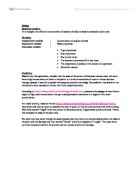Design
Research question
To investigate the effects of concentration of sodium chloride towards the osmosis in plant cells
Variables
Independent variable : Concentration of sodium chloride
Dependent variable : Mass of potatoes
Controlled variable :
- Type of potatoes
- Size of potatoes
- Size of cork borer
- The duration of potatoes left in test tubes
- The temperature, humidity of the location of experiment
- Electronic balance
Prediction
Based on my first speculation, I predict that the mass of the potato will decrease because water will move from a high concentration of water in the potato to a lower concentration of water in the salt solution through osmosis. I was able to predict this using my scientific knowledge. My prediction was similar to the information about osmosis on the site that I have researched below.
According to , osmosis is the passage of water from a region of high water concentration through a semi-permeable membrane to a region of low water concentration.
In a closer scrutiny, based on the site , when plant cells take up water by osmosis they start to swell, but the cell wall prevents them from bursting. Plant cells become "turgid" when they are put in diluted solutions. Turgid means swollen and hard. Hence, this increases the mass of the plant cells.
But when they lose water through the same process when they are put in concentrated solution, the mass of the plant cells will decrease and they become "flaccid” which is an opposite of “turgid”. The water move out from the potato and into the solution and the volume of solution increases.
Method
- Prepare apparatuses ; potatoes, cork borer, chopping board, salt, test tubes, scalpel, ruler, electronic balance, test tube racks, distilled water and beakers.
- Take 5 test tubes and place 5 test tubes in each rack. Label the racks 2%, 4%, 6%, 8% and 10% and A, B, C, D, and E for different test tubes.
- Using the cork borer with a diameter of 5 mm, carefully cut out 5 pieces of potatoes.
- Measure the lengths of the cut-out potatoes with the similar measurement which is 30mm with a ruler. Then, using a scalpel to cut the slices of potatoes and making sure that they are 30mm each.
- Prepare 5 volumetric flasks of 1000 ml distilled water in each of them.
- Measure and add 20g into the 1000ml volumetric flask to obtain a 2% concentrated salt solution.
- Then pour the solution of 100ml into the 5 test tubes in the 2% rack.
- Repeat steps 6-10 with 40g, 60g, 80g and 100g of salt to obtain 2%, 4%, 6%, 8% and 10% of salt concentrated solution.
- Then weigh every potato slices on an electronic balance and recorded the weights.
- Drop a potato sample into a boiling tube as promptly as possible; give a two minute interval before dropping potato samples into the next set of boiling tubes.
- Leave the experiments for 30 minutes. (refer to Figure 1)
- After 30 minutes, drain out the solutions in the sink and place all the slices on a paper towel in the order that I had put them in the test tubes to avoid confusion.
- Dry each slice with the paper towel to dry off excess water and then place each one on the scales to weigh them.
- Measure each potato accurately on the electronic scale.
- Record the results in a table.








